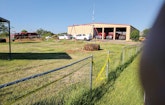
The gravity-flow system for the Whetstone Fire District firehouse in Huachuca City, Arizona, includes a 1,500-gallon septic tank and 64 Infiltrator Water Technologies Quick4 HC chambers in four trenches.
Septage backing into the Whetstone Fire District firehouse in Huachuca City, Arizona, brought service provider Sierra Vista Plumbing on
the run.
Laborer David Maeding ran a Maxi-Rooter (General Pipe Cleaners) down the house lateral to the 1,500-gallon septic tank. The 4-inch pipe was unobstructed. He then pulled the almost submerged effluent filter in the tank, but the liquid level remained static.
Unable to determine the problem, Maeding called sister company American Septic Service in Sierra Vista to pump the tank, which didn’t solve the problem. The station is home to six full-time firemen and an office manager.
Peter Bidon, district fire chief, hired American Septic Service to troubleshoot the situation. Foreman Zachary “Zack” Long used a Caterpillar 416F2 backhoe loader to excavate the tank. As he removed soil from around the outlet, wastewater poured into the hole through the gap where the 4-inch supply line had never been sealed to the tank.
To stop further environmental contamination, Bidon closed the station’s lavatories and rented two portable restrooms. Meanwhile, Long continued his exploration and found the badly deformed plastic distribution box full of sludge. Moving to the stone-and-pipe drainfield, he noted the first two 84-foot laterals were clogged with sludge. The third trench had never seen effluent because the lightweight PVC supply line had been squashed flat.
Bidon hired American Septic Service to replace the system. “We were in the middle of our wildfire season,” says Dawn Long, the company’s field coordinator and septic designer. “If all 17 firehouse personnel and some surrounding districts responded to a blaze, two portable restrooms at the location would provide insufficient sanitary facilities, and there’s no guarantee more units would be available during the emergency. We had to move on this and fast.”
Long worked with county officials to expedite the septic permit. “It was approved in four days instead of the usual six to eight weeks,” she says. Zack Long and septic technician Tyler Thomas installed the gravity-flow and chambers system in two days, setting a company record.
Site conditions
Soils are sandy clay loam with an absorption rate of 0.40 gpd per square foot. Groundwater is not a factor.
System components
Dawn Long designed the system to handle 750 gpd. Major components include the following:
1,500-gallon dual-compartment oval concrete tank (Padilla Precast).
EF-6 effluent filter and seven-hole distribution box (TUF-TITE).
64 Quick4 HC chambers with inspection ports (Infiltrator Water Technologies).
System operation
Wastewater and graywater from showers flow 50 feet through a 4-inch PVC pipe to the septic tank. Effluent from the tank flows 15 feet to the distribution box feeding four 64-foot-long trenches, each with 16 48-by-31-by-16-inch-high chambers spaced 15 feet side to side.
Installation
Constricting setbacks forced Long to sandwich the septic tank between the first and second original drainfield trenches and to locate the distribution box and delivery lines in the third trench. To ensure 100 percent accuracy, Zack Long and Thomas spent the first day measuring and staking out boundaries. They ran string to delineate the piping and components, then sprayed white marking paint under the twine.
The next morning, Long excavated the 10-by-12-by-10-foot-deep hole for the tank and bedded it with compacted pea gravel. The Padilla driver and Thomas set the tank, then Long conducted a 24-hour water test to check for leaks per the state septic code.
“I specify Padilla tanks because their round corners and tee-baffles distribute influent more evenly,” Dawn Long says. “It smoothly circles around and goes down with minimal disturbance to settling.”
Zack Long saw-cut a 2-foot-wide section of asphalt parking lot to intercept the firehouse lateral. After exposing the pipe, he excavated a 3-foot-deep trench to the septic tank, laid the lateral, and connected the two lines with a 45-degree PVC elbow.
“We bed all piping and components on compacted pea gravel, then photograph the evidence,” Long says. “After laying the piping, we cover it with more pea gravel to protect it while backfilling.”
Because the state’s point-of-sale inspection form asks if the distribution box was opened for inspection and its operational status, Dawn Long specifies a 24-inch riser to bring boxes to grade. “This practice ensures fast access for troubleshooting and to the speed levelers in case a trench is ponding,” she says.
“D-boxes must be bedded solidly to prevent movement during backfilling,” Long continues. “If they move, all hope is lost for equal distribution. It’s a misconception that if equal flow is established with speed levelers, then equal absorption will occur in the trenches. It doesn’t. Trenches absorb at individual rates.”
Zack Long set the distribution box at 3 feet deep, then began excavating the trenches while Thomas installed the chambers. They finished the drainfield the second day and restored service to the firehouse. “We backfilled around the tank by adding native soil a little at a time, then soaking each layer with a hose,” Long says. “The soil was suitable for gardens, making this excavation the easiest we’ve ever done.”









